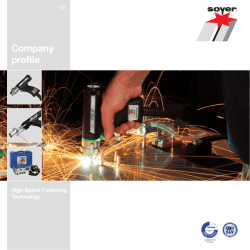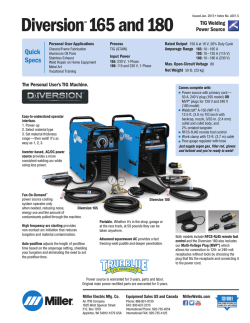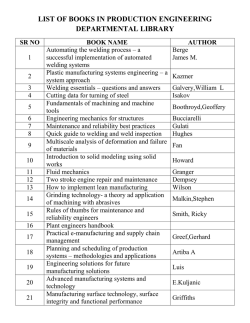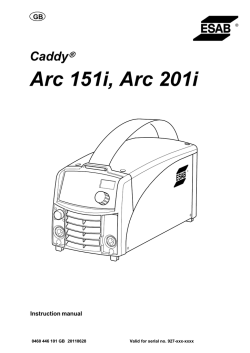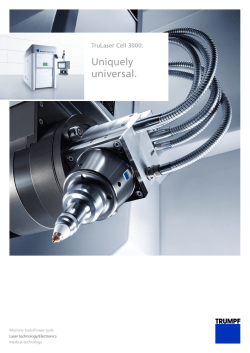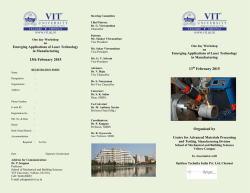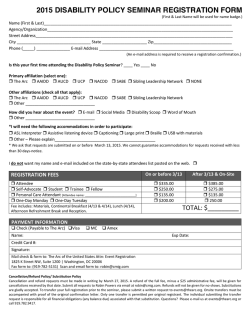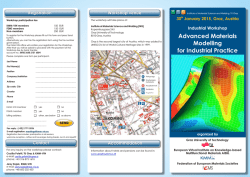
Owners Manual
IM2006 01/2011 Rev. 5 INVERTEC V205, V270 & V405 OPERATOR’S MANUAL ENGLISH LINCOLN ELECTRIC ITALIA S.r.l Via Fratelli Canepa 8, 16010 Serrà Riccò (GE), Italia www.lincolnelectric.eu Declaration of conformity LINCOLN ELECTRIC ITALIA S.r.l. Declares that the welding machine: INVERTEC V205 conforms to the following directives: 2006/95/CEE, 2004/108/CEE and has been designed in compliance with the following standards: EN 60974-1, EN 60974-10 (2005) Dario Gatti European Engineering Director Machines LINCOLN ELECTRIC ITALIA S.r.l., Via Fratelli Canepa 8, 16010 Serra Riccò (GE), Italia 12/05 English I English Declaration of conformity LINCOLN ELECTRIC ITALIA S.r.l. Declares that the welding machine: INVERTEC V270 conforms to the following directives: 2006/95/CEE, 2004/108/CEE and has been designed in compliance with the following standards: EN 60974-1, EN 60974-10 (2002) Dario Gatti European Engineering Director Machines LINCOLN ELECTRIC ITALIA S.r.l., Via Fratelli Canepa 8, 16010 Serra Riccò (GE), Italia 12/05 English II English Declaration of conformity LINCOLN ELECTRIC ITALIA S.r.l. Declares that the welding machine: INVERTEC V405 conforms to the following directives: 2006/95/CEE, 2004/108/CEE and has been designed in compliance with the following standards: EN 60974-1, EN 60974-10 (2003) Dario Gatti European Engineering Director Machines LINCOLN ELECTRIC ITALIA S.r.l., Via Fratelli Canepa 8, 16010 Serra Riccò (GE), Italia 12/05 English III English 12/05 THANKS! For having choosen the QUALITY of the Lincoln Electric products. Please Examine Package and Equipment for Damage. Claims for material damaged in shipment must be notified immediately to the dealer. For future reference record in the table below your equipment identification information. Model Name, Code & Serial Number can be found on the machine rating plate. Model Name: ………………...…………………………….………………………………………………………………………………………….. Code & Serial number: ………………….……………………………………………….. …………………………………………………….…………….. Date & Where Purchased: …………………………………………………………………... ……………………….………………………………………….. ENGLISH INDEX Safety .............................................................................................................................................................................. 1 Installation and Operator Instructions .............................................................................................................................. 2 Electromagnetic Compatibility (EMC) .............................................................................................................................. 7 Technical Specifications .................................................................................................................................................. 7 WEEE .............................................................................................................................................................................. 8 Spare Parts...................................................................................................................................................................... 9 Electrical Schematic ........................................................................................................................................................ 9 Accessories ..................................................................................................................................................................... 9 English IV English Safety 01/11 WARNING This equipment must be used by qualified personnel. Be sure that all installation, operation, maintenance and repair procedures are performed only by qualified person. Read and understand this manual before operating this equipment. Failure to follow the instructions in this manual could cause serious personal injury, loss of life, or damage to this equipment. Read and understand the following explanations of the warning symbols. Lincoln Electric is not responsible for damages caused by improper installation, improper care or abnormal operation. WARNING: This symbol indicates that instructions must be followed to avoid serious personal injury, loss of life, or damage to this equipment. Protect yourself and others from possible serious injury or death. READ AND UNDERSTAND INSTRUCTIONS: Read and understand this manual before operating this equipment. Arc welding can be hazardous. Failure to follow the instructions in this manual could cause serious personal injury, loss of life, or damage to this equipment. ELECTRIC SHOCK CAN KILL: Welding equipment generates high voltages. Do not touch the electrode, work clamp, or connected work pieces when this equipment is on. Insulate yourself from the electrode, work clamp, and connected work pieces. ELECTRICALLY POWERED EQUIPMENT: Turn off input power using the disconnect switch at the fuse box before working on this equipment. Ground this equipment in accordance with local electrical regulations. ELECTRICALLY POWERED EQUIPMENT: Regularly inspect the input, electrode, and work clamp cables. If any insulation damage exists replace the cable immediately. Do not place the electrode holder directly on the welding table or any other surface in contact with the work clamp to avoid the risk of accidental arc ignition. ELECTRIC AND MAGNETIC FIELDS MAY BE DANGEROUS: Electric current flowing through any conductor creates electric and magnetic fields (EMF). EMF fields may interfere with some pacemakers, and welders having a pacemaker shall consult their physician before operating this equipment. CE COMPLIANCE: This equipment complies with the European Community Directives. ARTIFICIAL OPTICAL RADIATION: According with the requirements in 2006/25/EC Directive and EN 12198 Standard, the equipment is a category 2. It makes mandatory the adoption of Personal Protective Equipments (PPE) having filter with a protection degree up to a maximum of 15, as required by EN169 Standard. FUMES AND GASES CAN BE DANGEROUS: Welding may produce fumes and gases hazardous to health. Avoid breathing these fumes and gases. To avoid these dangers the operator must use enough ventilation or exhaust to keep fumes and gases away from the breathing zone. ARC RAYS CAN BURN: Use a shield with the proper filter and cover plates to protect your eyes from sparks and the rays of the arc when welding or observing. Use suitable clothing made from durable flame-resistant material to protect you skin and that of your helpers. Protect other nearby personnel with suitable, non-flammable screening and warn them not to watch the arc nor expose themselves to the arc. WELDING SPARKS CAN CAUSE FIRE OR EXPLOSION: Remove fire hazards from the welding area and have a fire extinguisher readily available. Welding sparks and hot materials from the welding process can easily go through small cracks and openings to adjacent areas. Do not weld on any tanks, drums, containers, or material until the proper steps have been taken to insure that no flammable or toxic vapors will be present. Never operate this equipment when flammable gases, vapors or liquid combustibles are present. WELDED MATERIALS CAN BURN: Welding generates a large amount of heat. Hot surfaces and materials in work area can cause serious burns. Use gloves and pliers when touching or moving materials in the work area. English 1 English SAFETY MARK: This equipment is suitable for supplying power for welding operations carried out in an environment with increased hazard of electric shock. EQUIPMENT WEIGHT OVER 30kg: Move this equipment with care and with the help of another person. Lifting may be dangerous for your physical health. HF CYLINDER MAY EXPLODE IF DAMAGED: Use only compressed gas cylinders containing the correct shielding gas for the process used and properly operating regulators designed for the gas and pressure used. Always keep cylinders in an upright position securely chained to a fixed support. Do not move or transport gas cylinders with the protection cap removed. Do not allow the electrode, electrode holder, work clamp or any other electrically live part to touch a gas cylinder. Gas cylinders must be located away from areas where they may be subjected to physical damage or the welding process including sparks and heat sources. CAUTION: The high frequency used for contact-free ignition with TIG (GTAW) welding, can interfere with the operation of insufficiently shielded computer equipment, EDP centers and industrial robots, even causing complete system breakdown. TIG (GTAW) welding may interfere with electronic telephone networks and with radio and TV reception. Installation and Operator Instructions Read this entire section before installation or operation of the machine. The machines: V205 2V: V270: V270 2V: V405: Location and Environment This machine will operate in harsh environments. However, it is important that simple preventative measures are followed to assure long life and reliable operation. are designed to operate on engine driven generators as long as the auxiliary can supply adequate voltage, frequency and power as indicated in the "Technical Specification" section of this manual. The auxiliary supply of the generator must also meet the following conditions: Do not place or operate this machine on a surface with an incline greater than 15° from horizontal. Do not use this machine for pipe thawing. This machine must be located where there is free circulation of clean air without restrictions for air movement to and from the air vents. Do not cover the machine with paper, cloth or rags when switched on. Dirt and dust that can be drawn into the machine should be kept to a minimum. This machine has a protection rating of IP23S. Keep it dry when possible and do not place it on wet ground or in puddles. Locate the machine away from radio controlled machinery. Normal operation may adversely affect the operation of nearby radio controlled machinery, which may result in injury or equipment damage. Read the section on electromagnetic compatibility in this manual. Do not operate in areas with an ambient temperature greater than 40°C. Vac peak voltage: below 410V (for 230Vac input) or 720V (for 400Vac input). Vac frequency: in the range of 50 and 60 Hertz. RMS voltage of the AC waveform: V270, V405: 400Vac ± 15% V205 2V, V270 2V: 230Vac or 400Vac ± 10% It is important to check these conditions because many engine driven generators produce high voltage spikes. Operation of this machine on engine driven generators not conforming to these conditions is not recommended and may damage the machine. Output Connections A quick disconnect system using TwistMate cable plugs is used for the welding cable connections. Refer to the following sections for more information on connecting the machine for operation of stick welding (MMA) or TIG welding (GTAW). Input Supply Connection Check the input voltage, phase, and frequency supplied to this machine before turning it on. The allowable input voltage is indicated in the technical specification section of this manual and on the rating plate of the machine. Be sure that the machine is grounded. Stick Welding (MMA) Make sure the amount of power available from the input connection is adequate for normal operation of the machine. The fuse rating and cable sizes are both indicated in the "Technical Specification" section of this manual. English (230 / 400Vac, single phase) (400Vac, three phase) (230 / 400Vac, three phase) (400Vac, three phase) First determine the proper electrode polarity for the electrode to be used. Consult the electrode data for this information. Then connect the output cables to the output terminals of the machine for the selected polarity. For example, if DC(+) welding will be used then connect 2 English the electrode cable to the (+) terminal of the machine and the work clamp to the (-) terminal. Insert the connector with the key lining up with the keyway and rotate approximately ¼ turn clockwise. Do not over tighten. for more than five minutes, the fan will turn OFF. This reduces the amount of dirt that is deposited inside the machine and reduces power consumption. Refer to the Output LED section below for more information about conditions when the output of the machine is ON. For DC(-) welding switch the cable connections at the machine so that the electrode cable is connected to (-) and the work clamp is connected to (+). If a Coolarc 20 is connected to a "V2##-T / -TP", it will be turned ON and OFF with the operation of the fan. When Stick welding mode is used the Coolarc 20 will be OFF. TIG Welding (GTAW) This machine does not include a TIG torch necessary for TIG welding, but one may be purchased separately. Refer to the accessories section for more information. Most TIG welding is done with DC(-) polarity; connect the torch cable to the (-) terminal of the machine and the work clamp to the (+) terminal. Insert the connector with the key lining up with the keyway and rotate approximately ¼ turn clockwise. Do not over tighten. If a Coolarc 30 is connected to a "V405-T / -TP", it will be turned ON and OFF with the operation of the fan. When Stick welding mode is used the Coolarc 30 will be OFF. C. For "V###-S" machine, connect the gas hose from the TIG torch to a gas regulator on the cylinder of gas to be used. Gas Inlet (V###-T / -TP only): Connector for the TIG shielding gas. Use the supplied gas line and connector to connect the machine to the gas source. The gas source must have a pressure regulator and flow gage installed. D. Mode Switch: This switch changes the welding modes of the machine. The "V###-S" has two welding modes: Stick (SMAW) and Lift TIG (GTAW). The "V###-T / -TP" machines have three welding modes: Stick (SMAW), Lift TIG (GTAW) and HF TIG (GTAW). For "V###-T / -TP" machine, connect the gas hose from the TIG torch to the gas connector (B) on the front of the machine. If necessary, an extra gas connector for the fitting on the front of the machine is included in the package. Next, connect the fitting on the back of the machine to a gas regulator on the cylinder of gas to be used. An input gas line and the required fittings are also included in the package. Connect the TIG torch trigger to the trigger connector (A) on the front of the machine. Remote Control Connection Refer to the accessories section for a list of remote controls. If a remote control is used, it will be connected to the remote connector (C) on the front of the machine. The machine will automatically detect the remote control, turn on the REMOTE LED, and switch to remote control mode. More information on this mode of operation will be given in the next section. Controls and Operational Features WARNING Arc Striking Machine Usage Information (ASG machines only) The EN 60974-3 Standard specifies that the "ASG" equipment is intended to be used with mechanically guided torch. A. Power Switch: Controls the input power to the machine. Make sure the machine is properly connected to the input supply before turning the machine on. B. Fan: The cooling fan will turn ON when the machine is turned ON and it will continue to run whenever the output of the machine is ON. If the output of the machine is OFF English 3 English disabled. This normally occurs when the duty cycle of the machine has been exceeded. Leave the machine on to allow the internal components to cool. When the indicator turns off, normal operation is again possible. G. Remote LED: This indicator will turn on when a remote control is connected to the machine via the remote control connector. Using a remote control will change the function of the output current control, refer to the output current control section. H. Output LED: This indicator turns on when the output of the machine is on. Both the type of machine and the position of the mode switch determine when the output of the machine is turned on. When the mode switch is in the Stick position, the following welding features are enabled: V###-S: In the stick welding mode, the output of the machine is automatically turned ON. However, in the Lift TIG welding mode, the connection of a remote control determines if the output is ON or OFF. If a remote control is not connected (the Remote LED is OFF) then the output of the machine is automatically turned ON. If a remote control is connected (the Remote LED is ON) then the output of the machine is turned ON and OFF by the remote connector on the front of the machine. Hot Start: This is a temporary increase in the output current during the start of the stick welding process. This helps ignite the arc quickly and reliably. The amount of hot start can be adjusted on the "V###-S", refer to Hot Start, described below. Arc Force: This is a temporary increase in the output current during normal stick welding. This temporary increase in output current is used to clear intermittent connections between the electrode and the weld puddle that occur during normal stick welding. The amount of arc force can be adjusted on the "V###-S", refer to Arc Force, described below. Anti-Sticking: This is a function which decreases the output current of the machine to a low level when the operator makes an error and sticks the electrode to the work piece. This decrease in current allows the operator to remove the electrode from the electrode holder without creating large sparks which can damage the electrode holder. V###-T / -TP: In stick welding mode, the output of the machine is automatically turned ON. However, in both of the TIG welding modes, the output of the machine is turned ON and OFF by the TIG torch connected to the trigger connector on the front of the machine. I. When the mode switch is in the Lift TIG position, the stick welding functions are disabled and the machine is ready for Lift TIG welding. Lift TIG is a method of starting a TIG weld by first pressing the TIG torch electrode on the work piece in order to create a low current short circuit. Then, the electrode is lifted from the work piece to start the TIG arc. Stick Welding Mode: The meter displays the preset welding current but this is adjusted from the remote control as explained in the Output Current Control section. TIG Welding Modes: The meter displays the maximum output current which is set by the output current control knob. The preset welding current is then adjusted by the remote control, but it is not displayed on the meter. The last mode switch position, HF TIG, is only available on the "V###-T / -TP". When the mode switch is in this position, the stick welding functions are disabled and the machine is ready for HF TIG welding. During the HF TIG mode, the TIG arc is started by HF without pressing the electrode on the work piece. The HF used for starting the TIG arc will remain on for 6.5 seconds; if the arc is not started in this time limit, the trigger sequence must be restarted. E. F. V###-S: The machine have a Voltage / Current switch to change the displayed value on the meter. If this switch is set to voltage, the meter will always display the output voltage of the machine. J. Power LED: This indicator will flash on and off when the machine is first turned on. After approximately 2 seconds it will stop flashing and remain on to signal that the machine is ready. Output Current Control: This controls the output, or welding, current of the machine. The function of this control knob is changed if a remote control is connected. If the Remote LED is ON, this indicates that a remote control is connected and the function of the output current control will be: Thermal LED: This indicator will turn on when the machine is overheated and the output has been English Meter: This meter displays the preset welding current before welding and the actual welding current during welding. Like the output current control, the function of the meter is changed if a remote control is connected. If the Remote LED is ON, this indicates that a remote control is connected and the meter will display the following information before welding (during welding, the meter always displays the actual welding current): 4 English Stick Welding Mode: The remote control will adjust the output current of the machine: downslope time from 0.5 to 20 seconds. (The upslope time is always 0.5 seconds.) Refer to the trigger sequence section below to understand how downslope is activated. In Stick welding mode, this is not used. V205: from 5 to 200A V270: from 5 to 270A V405: from 5 to 400A S. Start/Crater Current Control (V###-TP only): This control knob will adjust the Start/Crater current from 10% to 90% of the welding current. For an explanation of the start/crater operation, refer to the trigger sequences explained below. T. Postflow Control (V###-T / -TP only): In the TIG welding modes, this control knob will adjust the shielding gas postflow time from 0.5 to 30 seconds. (The preflow time is always 0.5 seconds.) In Stick welding mode, this is not used. The output current control knob on the display panel is not used. TIG Welding Modes: The maximum output current of the machine is set by the output current control knob. Then the remote control adjusts the output current from the minimum output (5A) to the value set by the output current control knob. For example, if the output current control knob on the machine is set to 100A then the remote control will adjust the output current from a minimum of 5A to a maximum of 100A. K. L. U. VRD LED's (enabled on Australian Machines only): This machine is provided by VRD (Voltage Reduction Device) function: this reduces the voltage at the output leads. Hot Start (V###-S only): In stick welding mode, this controls the amount of current used during the start of the arc to help ignite the arc quickly and reliably. In TIG welding mode, this is not used. The VRD function is enabled by factory default only on machines that meet the AS 1674.2 Australian Standards. (C-Tick logo " " on/near the Rating Plate applied on the machine). Arc Force (V###-S only): In stick welding mode, this controls the amount of current used during any intermittent short circuiting of the electrode during welding. In TIG welding mode, this is not used. The VRD LED is ON when the Output Voltage is below 32V with the Machine at idle (no welding time). M. Trigger Mode Switch (V###-T / -TP only): This switch changes between 2-step and 4-step trigger sequences. For an explanation of these trigger sequences refer to the trigger sequences explained below. For others machines this function is disabled (the LED is always OFF). TIG Trigger Sequences N. Pulsing Mode Switch (V###-TP only): In the TIG welding modes, this switch turns the pulsing function ON and controls the pulsing frequency range (20Hz or 300Hz). In Stick welding mode, this is not used. TIG welding can be done in either the 2-step or 4-step mode. The specific sequences of operation for these two trigger modes are explained below. 2-Step TIG Sequence With the 2-step trigger mode and a TIG welding mode selected, the following welding sequence will occur. The Pulsing LED next to the Pulsing Mode Switch shows the pulsing frequency when pulsing is turned ON. With this indication, the operator can adjust the frequency to the desired value before welding. (Note: At higher frequencies the LED flashes very fast and seems to be continuously ON however it is pulsing.) O. Pulsing Frequency Control (V###-TP only): When the pulsing function is ON, this control knob will adjust the pulsing frequency. The pulsing frequency adjustment range is 0.2-20Hz or 3-300Hz depending on the Pulsing Mode Switch position. P. Pulsing On-time Control (V###-TP only): When the pulsing function is ON, this control knob will adjust the pulsing on-time. The on-time can be adjusted from 10% to 90% of the pulsing period. Q. Pulsing Background Current Control (V###-TP only): When the pulsing function is ON, this control knob will adjust the pulsing background current. This is the current during the low portion of the pulse waveform; it can be adjusted from 10% to 90% of the welding current. R. Downslope Control (V###-T / -TP only): In the TIG welding modes, this control knob will adjust the English 5 1. Press and hold the TIG torch trigger to start the sequence. The machine will open the gas valve to start the flow of the shielding gas. After the preflow time, to purge air from the torch hose, the output of the machine is turned ON. At this time the arc is started according to the selected welding mode. After the arc is started the output current will be increased at a controlled rate, or upslope time, until the Welding current is reached. 2. Release the TIG torch trigger to stop welding. The machine will now decrease the output current at a controlled rate, or downslope time, until the Crater current is reached and the output of the machine is English factory. If the weld is completely finished, use the following sequence instead of step 3 described above. turned OFF. After the arc is turned OFF, the gas valve will remain open to continue the flow of the shielding gas to the hot electrode and work piece. 3A. Quickly press and release the TIG torch trigger. The machine will now decrease the output current at a controlled rate, or downslope time, until the Crater current is reached and the output of the machine is turned OFF. After the arc is turned OFF the postflow time will start. 4. Release the TIG torch trigger. The output current will again increase to the Welding current, like in step 2, to continue welding. When the main part of the weld is complete go to step 3. As shown here, after the TIG torch trigger is quickly pressed and released from step 3A, it is possible to press and hold the TIG torch trigger another time to end the downslope time and maintain the output current at the Crater current. When the TIG torch trigger is released the output will again increase to the Welding current, like in step 4, to continue welding. When the main part of the weld is complete go to step 3. As shown above, it is possible to press and hold the TIG torch trigger a second time during downslope to end the downslope function and maintain the output current at the Crater current. When the TIG torch trigger is released the output will turn OFF and the postflow time will start. This operation, 2-step restart disabled, is the default setting from the factory. 4-Step Sequence With the 4-step trigger mode and a TIG welding mode selected, the following welding sequence will occur. As shown here, again after the TIG torch trigger is quickly pressed and released from step 3A, it is possible to quickly press and release the TIG torch trigger a second time to end the downslope time and stop welding. 1. 04/03 Press and hold the TIG torch trigger to start the sequence. The machine will open the gas valve to start the flow of the shielding gas. After the preflow time, to purge air from the torch hose, the output of the machine is turned ON. At this time the arc is started according to the selected welding mode. After the arc is started the output current will be at the Start current. This condition can be maintained as long or as short as necessary. Maintenance WARNING For any maintenance or repair operations it is recommended to contact the nearest technical service center or Lincoln Electric. Maintenance or repairs performed by unauthorized service centers or personnel will null and void the manufacturers warranty. If the Start current is not necessary, do not hold the TIG torch trigger as described at the beginning of this step. In this condition, the machine will pass from Step 1 to Step 2 when the arc is started. 2. 3. The frequency of the maintenance operations may vary in accordance with the working environment. Any noticeable damage should be reported immediately. Releasing the TIG torch trigger starts the upslope function. The output current will be increased at a controlled rate, or upslope time, until the Welding current is reached. Press and hold the TIG torch trigger when the main part of the weld is complete. The machine will now decrease the output current at a controlled rate, or downslope time, until the Crater current is reached. This Crater current can be maintained as long or as short as necessary. Check cables and connections integrity. Replace, if necessary. Keep clean the machine. Use a soft dry cloth to clean the external case, especially the airflow inlet / outlet louvers. WARNING Do not open this machine and do not introduce anything into its openings. Power supply must be disconnected from the machine before each maintenance and service. After each repair, perform proper tests to ensure safety. This sequence has an automatic restart so welding will continue after this step. This operation, 4-step restart enabled, is the default setting from the English 6 English Electromagnetic Compatibility (EMC) 01/11 This machine has been designed in accordance with all relevant directives and standards. However, it may still generate electromagnetic disturbances that can affect other systems like telecommunications (telephone, radio, and television) or other safety systems. These disturbances can cause safety problems in the affected systems. Read and understand this section to eliminate or reduce the amount of electromagnetic disturbance generated by this machine. This machine has been designed to operate in an industrial area. The operator must install and operate this equipment as described in this manual. If any electromagnetic disturbances are detected the operator must put in place corrective actions to eliminate these disturbances with, if necessary, assistance from Lincoln Electric. The Class A equipment is not intended for use in residential locations where the electrical power is provided by the public low-voltage supply system. There may be potential difficulties in ensuring electromagnetic compatibility in those locations, due to conducted as well as radiated disturbances. This equipment does not comply with IEC 61000-3-12. If it is connected to a public low-voltage system, it is responsibility of the installer or user of the equipment to ensure, by consultation with the distribution network operator if necessary, that the equipment may be connected. Before installing the machine, the operator must check the work area for any devices that may malfunction because of electromagnetic disturbances. Consider the following. Input and output cables, control cables, and telephone cables that are in or adjacent to the work area and the machine. Radio and/or television transmitters and receivers. Computers or computer controlled equipment. Safety and control equipment for industrial processes. Equipment for calibration and measurement. Personal medical devices like pacemakers and hearing aids. Check the electromagnetic immunity for equipment operating in or near the work area. The operator must be sure that all equipment in the area is compatible. This may require additional protection measures. The dimensions of the work area to consider will depend on the construction of the area and other activities that are taking place. Consider the following guidelines to reduce electromagnetic emissions from the machine. Connect the machine to the input supply according to this manual. If disturbances occur if may be necessary to take additional precautions such as filtering the input supply. The output cables should be kept as short as possible and should be positioned together. If possible connect the work piece to ground in order to reduce the electromagnetic emissions. The operator must check that connecting the work piece to ground does not cause problems or unsafe operating conditions for personnel and equipment. Shielding of cables in the work area can reduce electromagnetic emissions. This may be necessary for special applications. Technical Specifications V205 2V: Input Voltage 230 / 400V 10% Single Phase Duty Cycle INPUT Input Power at Rated Output 5.5kW @ 100% Duty Cycle 6.5kW @ 35% Duty Cycle RATED OUTPUT AT 40°C Output Current EMC Class A Frequency 50/60 Hz Output Voltage (Based on a 10 min. period) 100% 35% 170A 200A OUTPUT RANGE 26.8 Vdc 28.0 Vdc Maximum Open Circuit Voltage 48 Vdc (CE model) 32 Vdc (AUSTRALIA model) RECOMMENDED INPUT CABLE AND FUSE SIZES Fuse or Circuit Breaker Size Input Power Cable 2 32A Superlag (230 / 400V input) 3 Conductor, 4mm PHYSICAL DIMENSIONS Height Width Length Weight 385 mm 215 mm 480 mm 14.1 - 15.1 Kg Operating Temperature Storage Temperature –10°C to +40°C -25°C to +55°C Welding Current Range 5 - 200 A English 7 English V270, V270 ASG, V270 2V & V270 2V ASG: INPUT Input Voltage 400V 15% (V270) 230 / 400V 10% (V270 2V) Three Phase Duty Cycle Input Power at Rated Output 6.5kW @ 100% Duty Cycle 9.9kW @ 35% Duty Cycle RATED OUTPUT AT 40°C Output Current EMC Class A Frequency 50/60 Hz Output Voltage (Based on a 10 min. period) 100% 35% 200A 270A OUTPUT RANGE 28.0 Vdc 30.8 Vdc Maximum Open Circuit Voltage 48 Vdc (CE model) 32 Vdc (AUSTRALIA model) RECOMMENDED INPUT CABLE AND FUSE SIZES Fuse or Circuit Breaker Size Input Power Cable 2 20A Superlag (400V input) 4 Conductor, 2.5mm (V270) 2 4 Conductor, 4mm (V270 2V) 35A Superlag (230V input) PHYSICAL DIMENSIONS Height Width Length Weight 385 mm 215 mm 480 mm 13.5 - 14.5 Kg Operating Temperature Storage Temperature –10°C to +40°C -25°C to +55°C Welding Current Range 5 - 270 A V405: Input Voltage 400V 15% Three Phase Duty Cycle INPUT Input Power at Rated Output 11.3 kW @ 100% Duty Cycle 17.2 kW @ 35% Duty Cycle RATED OUTPUT AT 40°C Output Current EMC Class A Frequency 50/60 Hz Output Voltage (Based on a 10 min. period) 100% 35% 300A 400A OUTPUT RANGE 32.0 Vdc 36.0 Vdc Maximum Open Circuit Voltage 48 Vdc (CE model) 32 Vdc (AUSTRALIA model) RECOMMENDED INPUT CABLE AND FUSE SIZES Fuse or Circuit Breaker Size Input Power Cable 30A Superlag 4 Conductor, 4mm2 PHYSICAL DIMENSIONS Height Width Length Weight 500 mm 275 mm 610 mm 31 - 33 kg Operating Temperature Storage Temperature -10°C to +40°C -25°C to +55°C Welding Current Range 5 - 400 A WEEE English 07/06 English Do not dispose of electrical equipment together with normal waste! In observance of European Directive 2002/96/EC on Waste Electrical and Electronic Equipment (WEEE) and its implementation in accordance with national law, electrical equipment that has reached the end of its life must be collected separately and returned to an environmentally compatible recycling facility. As the owner of the equipment, you should get information on approved collection systems from our local representative. By applying this European Directive you will protect the environment and human health! 8 English Spare Parts 12/05 Part List reading instructions Do not use this part list for a machine if its code number is not listed. Contact the Lincoln Electric Service Department for any code number not listed. Use the illustration of assembly page and the table below to determine where the part is located for your particular code machine. Use only the parts marked "X" in the column under the heading number called for in the assembly page (# indicate a change in this printing). First, read the Part List reading instructions above, then refer to the "Spare Part" manual supplied with the machine, that contains a picture-descriptive part number cross-reference. Electrical Schematic Refer to the "Spare Part" manual supplied with the machine. Accessories V205-TP V270-T / -TP V405-TP W6100316R V205 V270 V405 W6100317R V205-TP V270-T / -TP V405-TP W8800072R V205 V270 V405 K10095-1-15M V205-TP V270-T / -TP V405-TP K870 English Trigger Connector (5 pins). Remote Connector (6 pins). Male Quick Connect Gas Fitting. Hand Amptrol. Foot Amptrol. 9 English
© Copyright 2025
